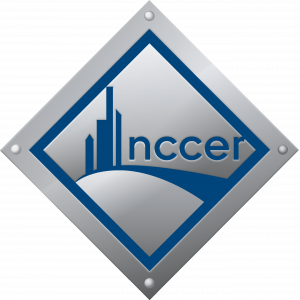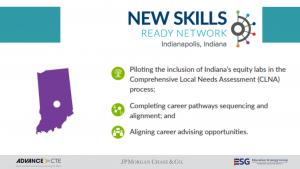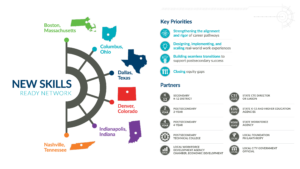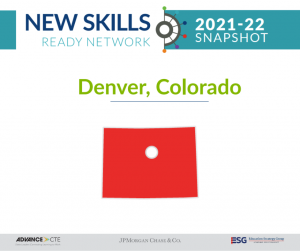 At their core, educational systems should work toward career readiness. Education should impart the skills and knowledge needed for learners to earn a living wage and become successful contributors to society.
At their core, educational systems should work toward career readiness. Education should impart the skills and knowledge needed for learners to earn a living wage and become successful contributors to society.
However, there appears to be a disconnect between education and employment in the United States. There are massive labor shortages and skills gaps in key industries. The student loan crisis has put thousands in debt for degrees they aren’t using. Around 86 percent of parents and learners say they wish they could get more real-world knowledge and skills during high school, while 54 percent of business leaders do not think the education system is teaching the skills needed for the workforce.
The construction industry has long been feeling the strain from this growing disconnect. That’s why the National Center for Construction Education and Research (NCCER) was founded. This non-profit has developed a standardized system of construction craft training to educate at the speed of industry, allowing accredited programs to teach real-world skills needed for in-demand jobs.
Here’s how NCCER’s system works to reconnect education with employment.
Standardization Across Construction
For industry and education to work seamlessly, they must be in sync with one another.
For much of construction history, the transfer of knowledge between generations has not been consistent, with different companies or master craftsmen teaching new people in many different ways. This style of training is not scalable or portable.
To overcome this issue, NCCER has established a common model for training, testing and credentialing in construction.
Now, NCCER curricula and programs are recognized and used by construction companies, associations, high schools, colleges, apprenticeships and other groups across the country. By having a consistent system in place nationwide, all parts of the construction training ecosystem can align together.
Curricula Developed by Experts
To ensure its educational standards are accurate and fulfilling the needs and expectations of the industry, NCCER’s curricula is developed with Subject Matter Experts (SMEs).
SMEs are experienced industry veterans who impart their wisdom by helping conceptualize, write and review components of NCCER curricula. Their influence can be seen in textbooks, module tests, performance profiles and more. As curricula are created or updated, these experts provide the guidance needed to ensure learners are learning the necessary skills to succeed in their career.
The standards set by NCCER aren’t designed to meet some arbitrary minimum threshold; they’re built by industry, for industry.
Modular Training and Credentials to Build Upon
Most construction learners don’t receive all their training at the same place or pace – many start in high school, then move to a community college or apprenticeship. To account for this, NCCER’s training is modular by design. Many curriculum tracks are also tiered, with up to four levels of advancement. This system offers a straightforward and logical progression of training.
The module and level-based system also sets the foundation for NCCER’s portable credentials, which are awarded to trainees upon completion of educational benchmarks. These credentials allow an individual trainee’s progress to be tracked in NCCER’s Registry System.
This model allows for a more efficient and effective training process. One program can hand off someone’s training to their next program and pick up exactly where they left off. Construction employers also receive clear insight into potential hires to understand their training status and receive recommendations for ongoing education.
Returning to Career-Oriented Training
Reconnecting the talent pipeline from education to employment doesn’t require reinventing the wheel. Career Technical Education (CTE) systems such as NCCER are based on classic models of career-oriented training that have built nations throughout history.
State CTE Directors can get connected to NCCER to start implementing its comprehensive construction education system. Reach out to your state’s designated workforce development representative or Pearson executive director to learn more about NCCER.
With the right focus and mentality, the American education system can once again be fully in sync with the needs of the economy and hiring companies across all trade sectors.
Jonathan Arnholz, Digital Communications Manager, National Center for Construction Education and Research (NCCER)
jarnholz@nccer.org


 In the next decade, job seekers in manufacturing will find plenty of openings. It’s projected that nearly 3.5 million manufacturing jobs will need to be filled in the next 10 years. The challenge, however, is that there aren’t enough qualified workers to fill the positions. An aging workforce, changing technologies, and misperceptions about the industry all contribute to the shortage. This has serious consequences for the manufacturing industry, which is overwhelmingly not prepared. In fact, nearly nine out of 10 manufacturers say that their company is having problems finding skilled workers in manufacturing.
In the next decade, job seekers in manufacturing will find plenty of openings. It’s projected that nearly 3.5 million manufacturing jobs will need to be filled in the next 10 years. The challenge, however, is that there aren’t enough qualified workers to fill the positions. An aging workforce, changing technologies, and misperceptions about the industry all contribute to the shortage. This has serious consequences for the manufacturing industry, which is overwhelmingly not prepared. In fact, nearly nine out of 10 manufacturers say that their company is having problems finding skilled workers in manufacturing.  For this post, Senior Policy Associate Dan Hinderliter interviewed Indiana State CTE Director Anthony Harl and Ascend Indiana Vice President and Co-founder Stephanie Bothun about driving intentional connections between state and local partners. In Indiana, the Office of Career and Technical Education (CTE) is embedded in the
For this post, Senior Policy Associate Dan Hinderliter interviewed Indiana State CTE Director Anthony Harl and Ascend Indiana Vice President and Co-founder Stephanie Bothun about driving intentional connections between state and local partners. In Indiana, the Office of Career and Technical Education (CTE) is embedded in the  Since this initial partnership developed through the
Since this initial partnership developed through the  In March 2021, Advance CTE released
In March 2021, Advance CTE released  Once DSD administration began conversations with educators and staff, they recognized the need to create schoolwide “Without Limits Teams,” comprised of a school administrator, special education staff, school counselors, and the school’s CTE coordinator. Last spring, school staff from each of the 25 DSD schools were each brought together in full day district-wide workshops structured on the five CTE Without Limits principles and designed using Advance CTE’s
Once DSD administration began conversations with educators and staff, they recognized the need to create schoolwide “Without Limits Teams,” comprised of a school administrator, special education staff, school counselors, and the school’s CTE coordinator. Last spring, school staff from each of the 25 DSD schools were each brought together in full day district-wide workshops structured on the five CTE Without Limits principles and designed using Advance CTE’s 



 The Attainment Network envisions an innovative education-to-workforce system that develops a diverse, talented workforce for current and future jobs, meets economic demands and sustains thriving communities. As The Network pursues this vision, their measure of success encompasses key evaluation questions embedded in equitable outcomes for learners. This includes measuring the number of diverse learners completing high-value credentials and receiving opportunities for high-wage, in-demand careers.
The Attainment Network envisions an innovative education-to-workforce system that develops a diverse, talented workforce for current and future jobs, meets economic demands and sustains thriving communities. As The Network pursues this vision, their measure of success encompasses key evaluation questions embedded in equitable outcomes for learners. This includes measuring the number of diverse learners completing high-value credentials and receiving opportunities for high-wage, in-demand careers.
 Hello! My name is Suela Cela and I am excited to be joining Advance CTE as Senior Policy Associate. In this role, I will be supporting Advance CTE in various projects to advance equity and access in Career Technical Education (CTE), including the Opportunity Gap Analysis workshop and pilot, the College in the High School Alliance partnership and launching an initiative focused on the use of stimulus funds for CTE.
Hello! My name is Suela Cela and I am excited to be joining Advance CTE as Senior Policy Associate. In this role, I will be supporting Advance CTE in various projects to advance equity and access in Career Technical Education (CTE), including the Opportunity Gap Analysis workshop and pilot, the College in the High School Alliance partnership and launching an initiative focused on the use of stimulus funds for CTE.